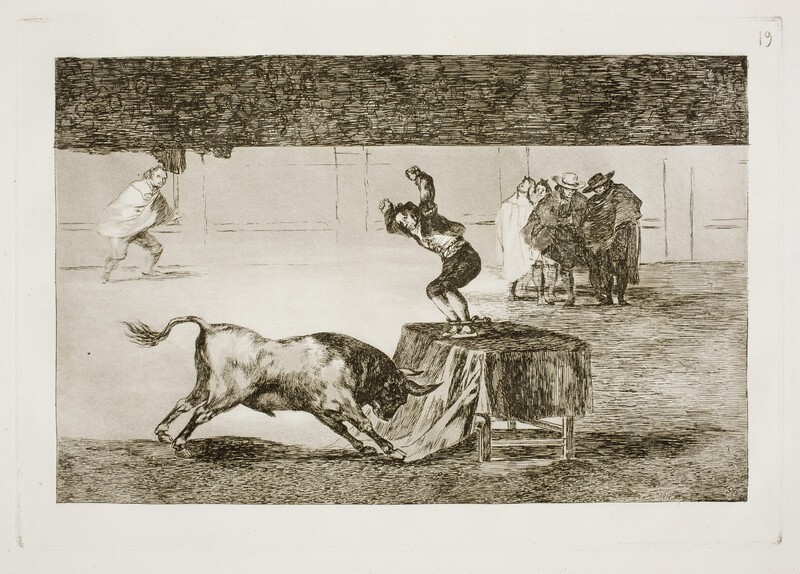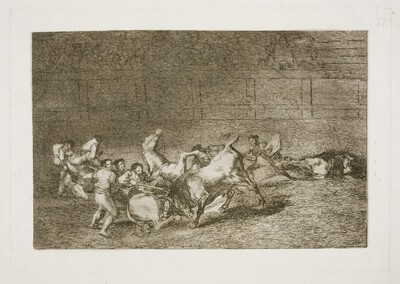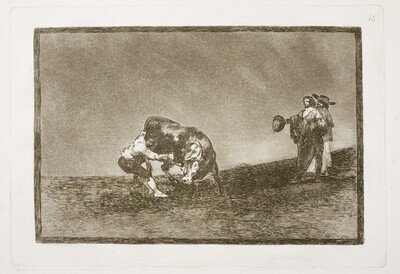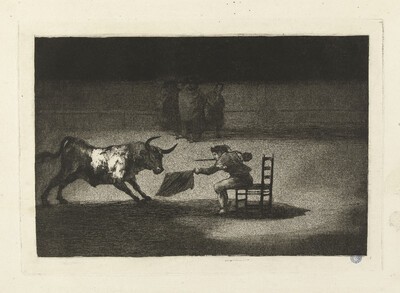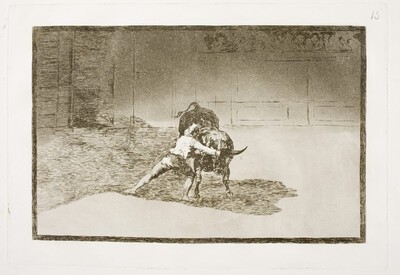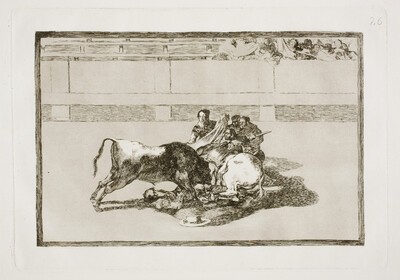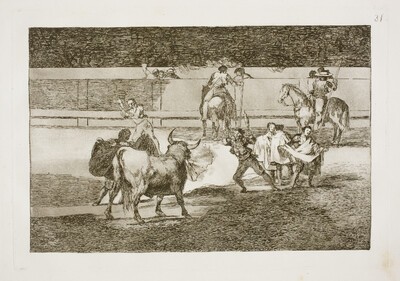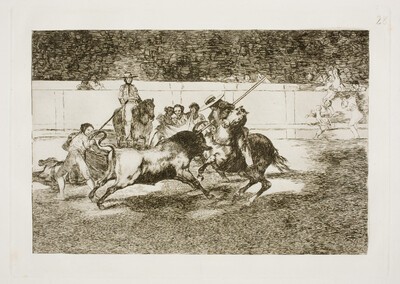- Cronología
- 1815
- Dimensiones
- 245 x 353 mm
- Técnica y soporte
- Aguafuerte, aguatinta, punta seca, buril y bruñidor
- Reconocimiento de la autoría de Goya
- Documented work
- Ficha: realización/revisión
- 01 Oct 2021 / 22 Jun 2023
- Inventario
- -
19 (print, upper right-hand corner)
1815 (print, under right-hand corner)
Goya (print, under right-hand corner)
See How the ancient Spaniards hunted bulls on horseback in the countryside.
Two state proofs are preserved: one before the additional aquatint and additional drypoint and burin touches, and the other before the additional burnishing and drypint and burin touches.
The plate is kept at the National Chalcography (no. 352).
See How the ancient Spaniards hunted bulls on horseback in the countryside.
The fourth of the five prints of the "extended" version of La Tauromaquia, dedicated to the exploits of Martincho (Nos. 15, 16, 18, 19 and H). It presents us with a somewhat bizarre scene in which the famous Martincho, in another of his madnesses, is on a table in the middle of the bullring and with shackles on his feet, about to jump over a bull, while five members of his cuadrilla (a bullfighting team) watch in the background. The detail with which Goya captures the facial features of the bullfighter, who waits on the table for the bull to charge, is striking.
Once again we have before us the barrier of the bullring, so that the spectator's point of view coincides with that of part of the audience in the lower part of the stands.The main part of the action takes place in the centre of the composition, but to the sides, at the back of the bullring, we can see various secondary characters, and further on, behind the barrier, we can sense the audience watching the bullfight from the stands. This part corresponding to the crowd is heavily striped in order to achieve a dark shading that contrasts markedly with the area of the barrier and the bullring itself, which are much brighter, except for the right-hand side of the latter, which is also in shadow, although less intense. This use of shading makes it possible to highlight a very limited area, the central part, where most of the action takes place. The bull's back is also illuminated, while his head is in shadow.
Von Loga believes that Goya may have witnessed the scene in his youth in the bullring in Saragossa. Glendinning, for his part, relates the somewhat distorted treatment of the faces, which in his opinion implies a criticism of those who participate in one way or another in a bullfight, to other engravings of Bullfighting, in particular with Martincho's recklessness in the Zaragoza Square, Ceballos himself, mounted on another bull, broke rejones in the bullring of Madrid, A bullfighter falls from his horse under the bull, The hard-working Rendón stinging a bull from whose fate he died in the bullring in Madrid, Fire flags, and Two groups of bullfighters run over at once by a single bull.
Sayre points out how Goya narrows the light to increase the tension and drama around the protagonists. He notes that the two main figures are smaller than in other prints. Both Sayre and Lafuente Ferrari correctly identify Martincho with Antonio Ebassun, the real name of the bullfighter, which has since been confirmed.
There is a preparatory drawing of the present print, also entitled Another madness in the same square.
-
Grabados y dibujos de Goya en la Biblioteca NacionalBiblioteca NacionalMadrid1946catalogue Elena Páez Ríos
-
Goya en la Biblioteca Nacional. Exposición de grabados y dibujos en el sesquicentenario de su muerteBiblioteca NacionalMadrid1978May - June 1978
-
Grabados de Goya: colección propiedad de la Biblioteca Nacional, que se conserva en su Gabinete deCasa de la Amistad de MoscúMoscow1979exhibition displayed from January 18th to 31st 1979
-
1984
-
Madrid1987
-
Madrid1990
-
Goya grabadorFundación Juan MarchMadrid1994consultant editors Alfonso E. Pérez Sánchez and Julián Gállego, from January 14th to March 20th 1994
-
Goya grabadorMuseo del Grabado Español ContemporáneoMarbella1996from March 8th to May 5th 1996
-
Zaragoza1996
-
Ydioma universal: Goya en la Biblioteca NacionalBiblioteca NacionalMadrid1996from September 19th to December 15th 1996cat. 285
-
Schlaf der Vernunft. Original radierungen von Francisco de GoyaMunich2000
-
Madrid2002
-
Madrid2002
-
Bilbao2012
-
Zaragoza2017
-
MunichKlinkhardt & Biermann1903p. 27
-
1946pp. 177-216, espec. pp. 198-199
-
BarcelonaTartessos-F. Oliver Branchfelt1946 (reed. 1951)
-
1961pp. 120-127
-
OxfordBruno Cassirer1964vol. II, 1964, p. 334, cat. 222
-
Vie et ouvre de Francisco de GoyaParísOffice du livre1970p. 278, cat. 1188
-
The Changing image: Prints by Francisco GoyaBostonMuseum of Fine Arts1974pp. 227-229, cat. 180-182
-
MilwakeeMilwaukee Art Museum1986p. 24
-
Goya, toros y torerosMadridMinisterio de Cultura, Comunidad de Madrid1990p. 102, cat. 34
-
MadridCaser-Turner1992pp. 31-32
-
Goya y Aragón. Familia, amistades y encargos artísticoscol. Col. Mariano de Pano y RuataZaragozaCaja de Ahorros de la Inmaculada de Aragón1995pp. 225-226
-
Catálogo de las estampas de Goya en la Biblioteca NacionalMadridMinisterio de Educación y Cultura, Biblioteca Nacional1996cat. 340
-
Ydioma universal: Goya en la Biblioteca NacionalMadridBiblioteca Nacional, Sociedad Estatal Goya 96 y Lunwerg1996p. 253
-
MadridMuseo Nacional del Prado2001pp. 72-74
-
Goya. In the Norton Simon MuseumPasadenaNorton Simon Museum2016pp. 186-201
